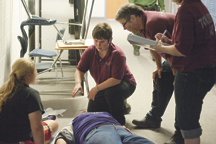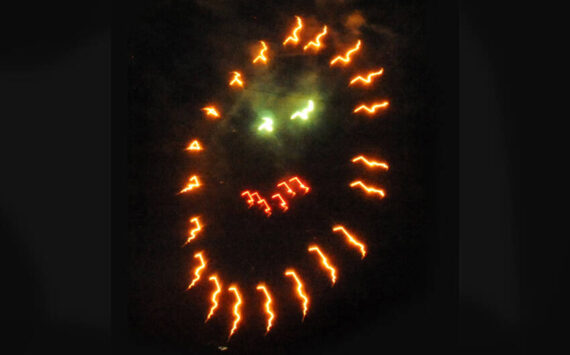
Tonasket EMS practices its response procedures on a pair of “victims” during Saturday’s school shooting drill. Photo by Brent Baker
TONASKET – Smoke and the sounds of gunfire filled the air, as did the moans and screams of fallen students and the shouts of law enforcement wading into an unknown, tense situation.
Thankfully, the students (and some adults) were acting, the gory wounds had been carefully applied by a makeup artist, the ammunition was the equivalent of mini-paintballs and the situation was a scenario designed by Tonasket police officer Jim Rice to train first responders who could be called to a shooting in a crowded school building.
The drill, held Saturday, July 14, at Tonasket High School, involved officers from the Tonasket and Oroville Police Departments, Border Patrol, Okanogan County Sheriff’s Office Emergency Manager Scott Miller, and area fire and EMS personnel. Tonasket reserve officer John Devlin drove from the Seattle area just for the training.
Playing their parts to add realism to the situation were about 15 students with a variety of very realistic wounds applied by Oroville Ambulance Coordinator Debra Donahue, a pair of student shooters, as well as volunteer adults.
Observers on hand included Tonasket School District superintendent Paul Turner, a handful of parents, a video crew and a reporter.
“I thought the training went very well,” Rice said. “Each year we make fewer mistakes, but we still made some.”
Actually, Rice said, the mistakes weren’t a bad thing, admitting that a perfect run-through might have meant the scenario was too easy.
“No matter how much training you’ve had, it still hones your skills,” he said. “It doesn’t make it foolproof. Every situation is different.”
Rice’s scenario faced police with multiple shooters who had already gunned down a number of students, a hostage situation, booby traps, and other unpleasant surprises. The student actors weren’t involved in the shooting action, but were directed to their spots to replicate what officers would encounter when they arrived on an active scene. Some played unconscious or dead victims, while others grabbed at officers as they went by or pleaded for help.
Officers and EMS ran through the scenario twice, with a different set of first-responders entering the scene each time.
“It was excellent training,” said Oroville officer Todd Hill, a nine-year veteran who was going through his first run through of one of Rice’s scenarios. “It really raises the stress level. We made some mistakes, but I’d rather make those mistakes here than in a real situation.
“It’s about as real as it can get. We need to do more of it.”
Tina Mikesell – on hand as a volunteer, not in her job as a mortician – played the part of a panicked adult that interfered with the officers’ efforts. In one scenario she was apprehended and forced to the floor, and in another was accidentally shot.
“The point was that I was supposed to scare them and distract them during hostage negotiations,” she said. “Things like that can happen. You don’t know what you’ll run into … I guess I did pretty good at that.
“I think it’s a wonderful activity to support our law enforcement,” Mikesell added. “It’s good practice. Hopefully it never happens, but it’s always good to prepare.”
Tonasket EMS director Michael Greene said his team, which went through the whole scenario twice, learned several things during its first run that it applied to the second time through.
“I have been in the fortunate, or unfortunate, position to be in probably half a dozen scenes with perhaps 10, 12, 15 patients in them,” Greene said. “So what I’ve learned … and what I want to implant in our team is keeping it simple, giving direct feedback.
“We have four or five lessons we’ve gotten out of this we’ll incorporate into our training.
I was very pleased and it was a great training opportunity.”
“We used the ICS (Incident Command System) program, and it just seemed to flow better this year,” said Tonasket police chief Robert Burks. “It was more organized.
“I think all the different agencies learned things we can improve on so if a real situation happens, or for training next year, it could flow even better.”
“The ICS is the most effective way to run any kind of incident,” Greene said. “That’s what we implemented in our situation – our own incident command system within the larger incident command structure that existed.
“It’s like a football team. Without a captain, in terms of running an incident … that’s where you see the chaos and confusion. But when you have a team and everybody knows their roles, and there is someone assigning them to their roles, it works really well. You get good feedback, it runs smoother, and it’s expandable.”
Both Burks and Rice were pleased with the turnout of volunteers this year, as well.
“It was a good turnout,” Burks said. “You want it as real as possible, and we’ve had years where we’ve had like five victims. It’s not the same as if you have 15 kids, some of them crying, saying ‘help me.'”
“The turnout was the best we’ve had,” Rice said. “I thought the EMS did a great job and the kids seemed to have some fun with it.
“You could see that (the officers) who hadn’t been through this before were a little more tense. But all of them get pumped when they go though this kind of training. It’s really the only way to begin to be ready for a situation like that.”
Turner said, after watching both run-throughs, that he hoped to coordinate additional training with law enforcement, perhaps on a Saturday during the school year, that would help school staff with preparation for such an incident.
“There is a need for more coordination with local authorities, both with what we do at the school and in the communication, transitioning over (to law enforcement) should there be such a scenario,” Turner said. “It’s obvious we need to do more trainings. That’s what Mr. Rice wants to do and I think he’s on the right track.”




